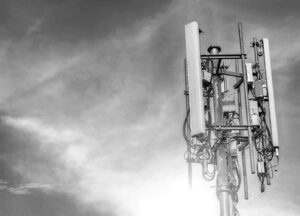Not so fast, please
A popular comedienne touts the hyper speed connectivity of 5G technology in playful commercials that offer free phones for switching to their network. Her disarming smile and a diverse cast of players suggest that no one in their right mind would settle for internet connections that are merely fast and that life without instantaneous downloading capability is hardly worth living.
Despite these blue sky promises, a proposal to revise the code governing deployment of wireless towers alarmed residents of rural Thurston County this fall who understand that the phased arrays, beam forming, omni-directional frequencies broadcast by 5-G technologies have been shown to degenerate vital cellular processes in living beings.
Every human has a unique electromagnetic signature which is vulnerable to low-level electromagnetic frequencies (EMFs). All “generations” (the G in 5G) of wireless technology harness electromagnetic microwave radiation. Whereas current 1G-4G broadcasts a limited range of frequencies from which humans are reasonably protected, 5G introduces over 3,000 additional frequencies.
Citizen opposition to the County’s proposed rules centered on the serious health risks associated with aggregated 5G towers; the short notice households would have before installation; and on the diminishing property values that would likely follow.
The opposition was so strong that County Planning Commission members took a step back. They created an advisory committee that would work with lawyers, county staff, and private providers to come up with new draft rules that put protection of public health first.
Research has identified health risks posed by proliferating EMFs
While information about the health dangers of EMFs continues to be absent from major news outlets, studies in many countries are consistent in their assessment of harm from exposure to low-level emissions.
Over the past 20 years, researchers worldwide have found that exposure to frequencies between 300 MHz and 3 GHz results in serious health dangers.
Martin Pall, PhD, professor emeritus at Washington State University, has written and lectured extensively on the Specific Absorption Rate (SAR) in human skin and how sweat ducts, which respond to signals and frequencies like tiny surface antennae, coupled with the conductive nature of water, heighten electromagnetic sensitivity. Over time, exposure to those frequencies results in molecular degeneration and altered DNA sequencing.
Devra Davis, PhD and master of public health in epidemiology, is the founder of Environmental Health Trust. In her book, Disconnect, she describes damage to skin, eyes and brains associated with microwave radiation and warns that children are far more vulnerable than adults to its accumulated absorption.
Lena Pu is an environmental health consultant for the National Association for Children and Safe Technologies (NACST.org). Her research on blood membranes proved that within 5-15 minutes of proximity to wireless microwave technology, healthy blood heats up, becomes sticky and essentially “cooks.”
More health risks—and more opportunities to make money
John Stottlemeyer, a citizen member of the advisory committee, estimates that he has spent hundreds of hours reviewing laws governing wireless towers and their installation. He explains that installation involves three entities: one company scouts the location for the tower, another company installs it, and a third company is the actual service provider, such as Verizon or T-Mobile.
Scouting companies are motivated to erect as many towers as possible because they make money on every tower they rent to providers. “The closer a tower is to a large power source, the less expensive it is for the installer,” Stottlemeyer says. “Companies prefer to erect towers where a power grid already exists, not necessarily where they are the most helpful. The goal of the citizens on the committee is to have the least number of facilities built, in the most efficient way, spread out to cover gaps in coverage and nowhere else.”
FCC guidelines favor telecom companies
Federal law appears to give local governments control over placement of wireless facilities, but municipalities tend to follow the advice of wireless providers who urge them to adopt FCC guidelines. These guidelines generally serve to make wireless installations “denser and bigger.” The advisory committee advocates an interpretation that there can be additional towers only if they fill a significant gap in coverage
And FCC Commissioners favor their former colleagues
Martin Pall warns the FCC is a “captured organization” in which high level executives formerly employed in the telecom industry are now in a position to regulate their friends. In February 2020, FCC Commissioners approved a 280 MHz (megahertz) spectrum for 5G that resulted in 5G towers being “deployed” across the country at a furious pace.
Norm Alster, writing in Captured Agency: How the Federal Communications Commission Is Dominated by the Industries It Presumably Regulates points out that The Telecommunications Act of 1996 removed zoning authority from local governments, stating that health concerns cannot be used as a reason to deny licenses for towers that are in FCC compliance:
“In preempting local zoning authority—along with the public‘s right to guard its own safety and health— Congress unleashed an orgy of infrastructure build-out. …industry has had a free hand in installing more than 300,000 sites. Church steeples, schoolyards, school rooftops, even trees can house these facilities.”
Will revised wireless regulations protect the health of Thurston residents?
The advisory committee members have proposed that facilities be placed as far from residential dwellings as possible and that testing be carried out to verify that the electromagnetic radiation is within FCC limits.
The committee also worked to ensure that right-of-way laws are strictly observed. The original draft allowed towers to be erected in a front, back or side yard with virtually no setback requirements. Those details, as well as the size of the towers, how many are needed, and whether environmental reviews should be submitted are all reconsidered in discussions on the new draft.
Stottlemeyer offers the experience of citizens in Petaluma, CA as a model for compromise in Thurston County. In 2018, people in Petaluma challenged their city’s interpretation of FCC guidelines and ultimately achieved strictly codified regulations for wireless carriers.
Stottlemeyer hopes that the evidence he and his fellow committee members provided at their November 10 meeting with staff and companies was sufficient to convince them that what committee members want is well within legal limits.” The challenge for the advisory committee is to convince the County that the best way to preserve property values and rural aesthetics is to abide by federal law rather than the FCC’s interpretations of it.”
Whatever the outcome of the rewrite, city and county residents will need to familiarize themselves with the details of their wireless codes and if they find them unacceptable, research pathways to revise them. “People don’t realize they can challenge the codes and ask for them to be rewritten.”
“Smart” meters—always on, always emittingSound Energy is currently replacing customers’ analog electric meters with Advanced Meter Installations (AMIs), commonly called “smart meters.” AMIs use a form of electromagnetic energy known as radiofrequency (RF) waves to measure energy usage in your home, transmitting it wirelessly to PSE. Industry proponents insist smart meters will eliminate the need for manual meter-reading, increasing the speed and accuracy of relaying usage data and lowering electric bills. Critics say the risks to human health outweigh any savings on bills, which are far from assured. By design, smart meters are always on, always transmitting data and emitting radiofrequency radiation. Despite US safety limits for RF (1,000 microwatts per square meter), Amy Myers, MD, says “it’s not uncommon for some smart meters to produce up to 60 times this amount.” Home appliances and cell phones use direct current (DC) of around 12 volts, while modern electrical circuits use alternating current (AC), at 120-240 volts. The constant conversion from DC to AC and the difference in voltages results in spikes and surges through a building’s wiring, creating ionizing radiation frequencies and electromagnetic interference (EMI). This “dirty electricity,” is thought by industry critics to be the source of symptoms like anxiety, disturbed sleep patterns and irregular heartbeat reported by some people who have smart meters installed outside their homes. Olympians can opt out of AMI installation by contacting PSE and requesting a Non-Communicating Meter Service Agreement. A charge of about $15 every other month will be added for the replacement and manual meter reading. Learn more at takebackyourpower.net or the multi-award-winning documentary Take Back Your Power. |

I have been an amateur radio operator for 43 years (W7PLC), I am “exposed” to RF at vastly higher levels than cell phones and multiple modes of modulation. So far I don’t have a third eye, (let me check the mirror). “Non-ionizing” radiation such as ham radio, CB radio, microwave ovens, cell phones only cause heat from exposure, I have been burned many times from my ham radio equipment. All the adverse effects that are listed in this article may come from “ionizing” radiation such as x-rays, nuclear radiation, etc. If you want to contest the 5G towers, the radiation is not going to cause anything listed in this article but the towers are ugly as sin and negatively affect property values. Don’t get caught up in all the conspiracy theories and use facts to back your position.